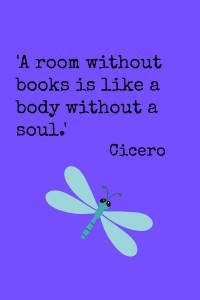Sally Murphy's Blog, page 55
August 9, 2015
August 8, 2015
Teacher Characters #5: Mrs Little
This is the last in my teacher-character series, where I’ve been talking about the various teachers who populate my books. It’s been an interesting experience for me, as I’ve noticed some similarities and also some differences which I hadn’t really stopped and thought about before, and now have ideas for future teacher characters as well.
Who is my teacher character? Mrs Little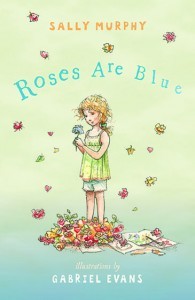
What book does she appear in? Roses are Blue, a verse novel illustrated by Gabriel Evans and published by Walker Books Australia.
Why is she there? A large proportion of this story is set at school. Amber, the main character, has faced some big changes in her life following her mum’s terrible car accident. Among those changes is a new school, and new friends. As she struggles to come to terms with Mum’s injuries and differences, she also worries about fitting in at her new school.
What role does she play? Although Mrs Little isn’t a major character, it is two of her actions which really drive the story forwards. First, she announces a Mother’s Day high tea, which leads to Amber confronting what her friends will think when they meet her mum, and secondly she has the whole class enter a local art competition, which gives Amber the opportunity to follow something she loves.
What did I learn writing about her? A reminder that not all my teacher characters are me! Mrs Little likes cooking and painting – two things I am really not good at. It was great to give her skills that are not mine.
Favourite Mrs Little moment? It’s not a major part of the story, but I love that Mrs Little encourages Leroy Jamieson, during art time. Amber says:
Mrs Little tells him it is very good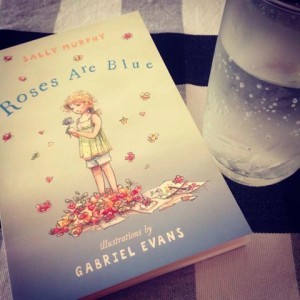
(even though it isn’t)
Then suggests he uses some colour
Instead of just his lead pencil.
When he is finished, Amber notes Leroy looks pretty proud. It’s Mrs Little’s encouragement that has given him that sense of pride. She’s a good teacher!
That concludes my series of posts about my teacher characters. If you have a favourite teacher character in a book you’ve read, I’d love for you to comment and tell me.
Roses are Blue, published by Walker Books is available in good bookstores and online.
A Found Poem: Mary MacKillop
Today is the feast day of Saint Mary MacKillop. I wanted to do a special post, but having blogged about her just recently, I was struggling a little for fresh words. Then I realised that the best words were those of Mary herself. She was a really inspirational lady and many of the things she said are still quoted today.
So, to mark the feast day, a found poem made from Mary’s words:
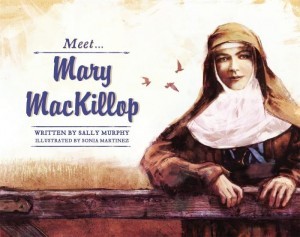 A Note for Fellow Travellers
A Note for Fellow Travellers
Never see a need
without doing something about it.
Remember we are but travellers here,
We must teach more by example than by word.
Do all you can with the means at your disposal
and calmly leave the rest to God.
To mark this special day, the Mary MacKillop Foundation has a special ‘Give Five for Mary’ campaign. You can donate here.
August 6, 2015
Poetry Friday And Bookshops
Today is Poetry Friday, and tomorrow is National Bookshop Day and these two things celebrate two of my very favourite things.
This week I had a day in the city, and I took a couple of hours to check out four bookshops. On a personal note I was delighted that three of them had Fly-In Fly-Out Dad, displayed face out (and multiple copies, too).
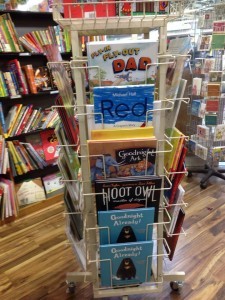
At Kaleido Books, Perth Train Station
The fourth didn’t, but had two of my other bookbabies, so that was wonderful, too.
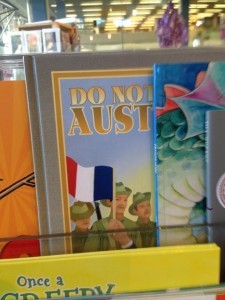
At the State Library Bookshop. they had Roses are Blue, too.
Anyway, I came home and I drafted this poem as a celebration of bookstores, and of their lovely staff.
A Note on Shopping
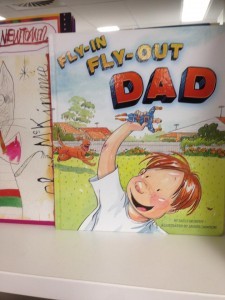
At Boffins Bookstore on William Street, Perth.
In supermarkets
people hurry
looking at lists
racing up and down aisles
or blocking them
to chat
‘Dreadful news.’
‘Had her baby’
‘Did you hear?’
In hardware stores
there are dusty aisles
bored looking
people who are NOT the ones
buying tools
and the staff never look
as happy
as they do
on those advertisements.
In bookshops though
there is
that new book smell
of unearthed treasures
awed hush
of discovery
excited squeals
and gasps
(not just
In the kids’ section)
and staff
who are happy
to come to work.
(Poem copyright Sally Murphy, 2015)
If you are a bookseller, have a wonderful Bookshop Day tomorrow. Thank you for making the world a better place. And if you are a reader, why not take the time to visit your local bookshop.
And today, enjoy Poetry Friday. The roundup this week is at The Opposite of Indifference.
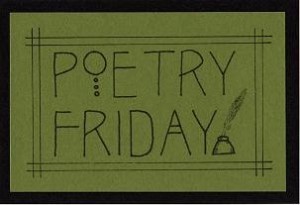
August 5, 2015
Teacher Characters #4: Mary MacKillop
As my series of posts about my teacher characters continues, today I move to a teacher character who is from history.
Who is my teacher character? Mary MacKillop
What book do they appear in? Meet Mary MacKillop, part of Random House Australia’s Meet… series.
Why are they there? The book attempts to tell Mary’s story – or at least part of it. I was approached by Random House Australia to contribute to the series, and delighted when they suggested Mary MacKillop as the subject, as she is such an important Australian.
What role do they play? She’s the main character and the topic of the book, which shows how and why she set up her first school in Penola, South Australia. Mary and her sisters had to overcome many obstacles to start their school and ensure children had access to education.
What did I learn writing about them? I thought she was significant because she was Australia’s first saint. What I realised was how amazing she was as a strong woman in a time when women were expected be seen and not heard. Her role in establishing schools throughout Australia was very significant.
Favourite Mary moment? In the book, it’s when she tells the rich lady that although her son is very welcome at the school, he will receive the same treatment as everybody else. In real life, I think my favourite Mary MacKillop moments are when she stood up to Bishops and Priests who tried to dictate to her and treated her very shabbily.
Meet Mary MacKillop, illustrated by Sonia Martinez, and published by Random House Australia is available in good bookstores and online.
August 3, 2015
Teacher Characters #3: Miss Timms
This is my third post about the teacher characters which appear in my books. If you’re enjoying them, I’d love for you to comment and tell me about your own favourite teacher character.
Who is my teacher character? Miss Timms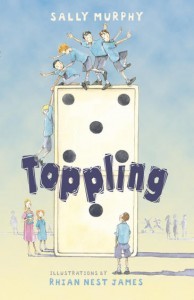
What book does she appear in? Toppling, illustrated by Rhian Nest James and published by Walker Books Australia.
Why is she there? A lot of the action in Toppling takes place at school as John and his mates struggle with the illness of their good friend, Dominic. Because of the number of school scenes, there needs to be a teacher. The way she interacts with her students is really significant to the plot of Toppling.
What role does she play? As the teacher of a class of year 6 students, she see them daily and knows them well. It is Miss Timms who has the job of telling the class that Dom is sick – and who also helps them deal with this. She is a really caring teacher, who seems to know how her students are feeling, and gives good guidance.
What did I learn writing about her? I wrote Toppling soon after I wrote Pearl Verses the World. I needed to be careful that Miss Timms and Miss Bruff were not too similar. I wanted them both to be nice people but not one-dimensional. So I learnt, as I wrote about Miss Timms, the importance of fleshing out a character who has only a few scenes. I show, for example, her impatience when Ky, the bully, is mean.
Favourite Miss Timms moment? The scene where Miss Timms announces that Dom won’t be coming back to school for a while because of his illness. I like it because it shows her efforts to be compassionate and honest, but still her level of uncertainty about how to deal with the situation. Good teachers are willing to show their human side to their students.
I hope you’re enjoying learning more about my teacher characters. Later this week I am going to post about my non-fiction teacher character, Mary MacKillop.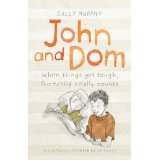
Toppling, published by Walker Books Australia is available from good bookstores and online. It is also published in the USA by Candlewick and, under the title John and Dom, by Walker UK.
August 2, 2015
August 1, 2015
Teacher Characters # 2: Miss Bruff
A few days ago I chatted about why I include teacher characters in my books, and introduced you to Stanley and Elizabeth from 1915. Today, I’d like you to meet, if you haven’t already, one of my favourite teacher characters.
Who is my teacher character? Miss Bruff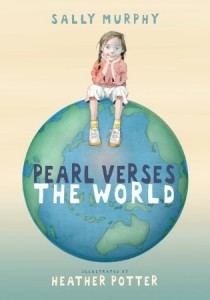
What book does she appear in? Pearl Verses the World
Why is she there? When I started writing about a lonely girl, I knew she was very lonely at school. Setting a large part of the story at school necessitated a teacher, but as soon as I introduced Miss Bruff with ‘her singsong voice’ and her passion for poetry, I knew she would be a major character in Pearl’s story.
What role do they play? For much of the book Miss Bruff seems an antagonist, she wants Pearl (and the rest of the class) to write rhyming poetry. Pearl hates it. She thinks Miss Bruff just doesn’t get her, But, when Pearl has something terrible happen in her life, she realises Miss Bruff is a lot more understanding that she seemed. And Miss Bruff learns from Pearl, too.
What did I learn writing about them? Miss Bruff reminds me a lot of myself as a teacher. Too often I just assume that if I’m enthusiastic about something, then my students will be, too. I learnt to perhaps stop and view things from my pupils’ viewpoints, and to remember that if there are twenty five kids in the class, there will twenty five different experiences.
Favourite Miss Bruff moment? I don’t want to give too much away, in case you haven’t read the story, but I love that Miss Bruff comes to see, after hearing Pearl read her poem outside of school, that poetry doesn’t always have to rhyme.
It is easy to portray teachers as either really nice or really horrible. I hope that readers of Pearl Verses the World, and my other books, can see that teachers can grow and learn, too. My next post in this series will look at Miss Timms from Toppling.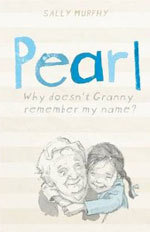
Pearl Verses the World, illustrated by Heather Potter and published by Walker Books , is available from good bookstores. It is also published in the US by Candlewick Press, and in the UK,under the title Pearl, by Walker UK.
July 30, 2015
Poetry Friday: Teachers
It’s Poetry Friday and this week I have been thinking about teachers, partly because I am always asked about which parts of my own life appear in my books, and also partly because I saw this amazing tribute to a teacher online, which made me weep.
Amazing, huh?
Anyway, as a result of this introspection, I’ve started blogging about the teacher characters in my various books – yesterday I posted about Stanley and Elizabeth in 1915, and over the next few weeks I am going to post about several of my other teacher characters. So, today I went looking for poems about teachers.
In Pearl Verses the World, Pearl has a bit of an up and down relationship with her teacher, Miss Bruff. She even writes a poem about her:
A teacher known as Bruff
Was very, very gruff.
She preached and she taught
Much more than she ought
Till the class had had more than enough.
Poor Miss Bruff! The good news is, by the end of the book, Pearl has a new understanding of Miss Bruff (who, incidentally, I’ll be blogging more about on Sunday).
One of my favourite poems about teachers is Taylor Mali’s poem, which you may have come across before. It begins:
What Teachers Make
by Taylor Mali
He says the problem with teachers is
What’s a kid going to learn
from someone who decided his best option in life
was to become a teacher?
You can read the whole poem on Mali’s website here or, you can see his performance here:
Teachers do make a difference. Thanks Taylor Mali – and thanks Mr Tamatea who was such an amazing teacher that 1700 students turned out to honour him. And thanks to the teachers who populate so many of my stories and do their best to guide my young characters, to cheer them on and to just teach them.
Have a great Poetry Friday. The roundup this week is at Keri Recommends.

July 29, 2015
Teacher Characters #1: Stanley and Elizabeth
I get asked all the time how much my books are inspired by my own life. While none of my stories is fully autobiographical, and I don’t like to embarrass my family by putting them directly into my stories, I know that things and people around me do influence my work, and even sneak into my books, sometimes unintentionally.
One thing I have noticed is the number of teachers in my books. One reason for this is that I write children’s books – and in most kids’ lives there are teachers. But, on top of that I was (am?) a teacher myself for so many years, that they sneak into my books even when I don’t plan on them being there. And, if I’m honest there’s a bit of me reflected in those teachers – either in the teacher I was, or the teacher I wish I was.
So, who are my teachers, and why are they there? In this series of posts, I’m going to introduce you to some of my teacher characters. First up, I’m going to talk about my most recent teacher characters.
Who is My Teacher Character? Stanley Moore, and his twin sister Elizabeth.
What Book do they appear in?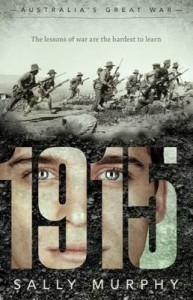
Australia’s Great War: 1915 (that’s Stanley, with the amazing eyes, on the front cover).
Why are they there?
When I was planning 1915, I needed a soldier character who young readers could relate to. I thought about an older brother, a teen who had put his age up, a parent, lots of things. But then I read about the impact of the Great War on school communities, and realised that Stanley could be a teacher, which would connect him with children back home. When I wondered who could be teaching his old students, I decided it could be his sister. This again would strengthen his links with the home front, which was a side of the war I really wanted to explore.
What role do they play?
Stanley is the book’s main character, and Elizabeth plays a strong supporting role. Stanley has left his teaching job behind to enlist in Word War 1 (also called the Great War), and Elizabeth is now teaching his former class. Stanley writes letters and poems for his students, and Elizabeth has them write back, helping them to understand what is happening at Gallipoli. Both show great compassion to their students, even at times when their own lives are difficult.
What did I learn writing about them?
1915 is my longest published novel, and so I learnt a lot about character development as I put myself into Stanley’s shoes, and then Elizabeth’s. I also learnt about the impact that having a teacher at war could have on the children back home, and on the whole school community. And, as a teacher, I was reminded that stuff that happens outside the classroom can have a big impact on what happens inside the classroom. I wish as a teacher that I could be as intuitive as this pair.
Favourite Stanley moment?
Spoiler alert. One of Stanley’s friends, Miles, is also the father of two of his students. When Miles is killed, Stanley takes the time to write to the boys and let them know their dad was a hero.
Do you have a favourite teacher character in a book you’ve read? I’d love to hear about him or her. And I’ll be back in a few days to talk about another of my teacher characters, Miss Bruff.
Australia’s Great War: 1915, published by Scholastic Australia, is available in all good bookstores.

